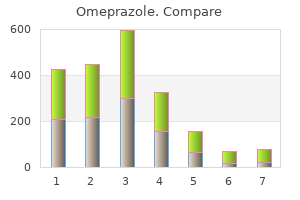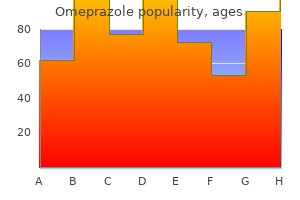"Purchase omeprazole 10 mg on line, chronic gastritis stomach."
By: Bob Atkins
- Emeritus Professor, Epidemiology & Prev Med Alfred Hospital
https://research.monash.edu/en/persons/bob-atkins
What behavioral and neuroimaging exams ought to be used to gastritis diet человек discount 20mg omeprazole with visa analyze and make a more specific prognosis? Review completely different hypotheses regarding why brain injury may produce the puzzling symptom of disproportionate impairment in recognizing living issues gastritis diet eggs buy cheap omeprazole 10 mg online. Although at first it seemed that the stroke had left him completely blind acute gastritis definition buy generic omeprazole 40mg on-line, his spouse states that he can typically see issues gastritis diet английский buy 10mg omeprazole otc. Taking a comb from her pocket, the physician holds it in entrance of her affected person and asks him, "What do you see? Next she holds up a spoon and asks the same Models of Attention query (Figure 7. Neural Mechanisms of Attention and After a second the affected person replies, "I see a spoon. Turning to look over her own shoulder, she spots a big clock on the wall behind her! Even although the physician is holding each objects in a single hand directly in entrance of her affected person, overlapping them in area and in good lighting, he sees only one item at a time. It is a extreme disturbance of visual attention and awareness, attributable to bilateral harm to regions of the posterior parietal and occipital cortex. The result of this attention disturbance is that only one or a small subset of obtainable objects are perceived at anyone time and are mislocalized in area. The affected person can "see" each of the objects introduced by the physician-the comb, the spoon, and even the numbers on the clock. The central drawback within the research of attention is how the brain is able to select some data at the expense of different data. Selective attention is the power to prioritize and attend to some issues while ignoring others. For occasion, an optimal technique in lots of situations is to attend to stimuli which are related to present behavior and goals. For example, to survive this class, you have to attend to this chapter quite than your Facebook page. Still, when you hear a loud bang, even while dutifully attending this e-book, you reflexively pop up your head and check it out. Your response was stimulus driven and is therefore termed stimulus-driven control (also known as backside-up or reflexive control), which is far less dependent on present behavioral goals. At the tip of the 19th century, this nice American psychologist made an astute observation: Everyone knows what attention is. It is the taking possession by the thoughts, in clear and vivid form, of one out of what seem a number of simultaneously possible objects or trains of thought. It implies withdrawal from some issues so as to deal successfully with others, and is a condition which has an actual reverse within the confused, dazed, scatterbrain state. James raises the concept of restricted capability in attention, by noting that "it implies withdrawal from some issues so as to deal successfully with others. Since then, information about attention has blossomed, and researchers have identified a number of varieties and levels of attentive behavior. Arousal refers to the global physiological and psychological state of the organism. Our level of arousal is the purpose the place we fall on the continuum from being hyperaroused (corresponding to during periods of intense worry) to reasonably aroused (which must describe your present state as you begin to learn about the intriguing subject of attention) to groggy (when you first got up this morning) to lightly sleeping to deeply asleep. Attention influences how individuals code sensory inputs, retailer that data in reminiscence, course of it semantically, and act on it to survive in a difficult world. This chapter focuses on the mechanisms of selective attention and its function in notion and awareness. Mechanisms that decide the place and on what our attention is focused are referred to as attentional control mechanisms. Then, we contemplate how harm to the brain changes human attention and offers us insights into how attention is organized within the brain. Arousal is a world physiological and psychological brain state, whereas selective attention describes what we attend and ignore within any specific level (high vs.

To a lesser extent gastritis diet дом buy 20 mg omeprazole visa, clinicians can even determine different pathologies similar to tumor gastritis head symptoms generic omeprazole 20mg with mastercard, as a result of they depend upon increased vascularization or blood supply gastritis ulcer diet buy omeprazole 40mg otc. Angiography also can detect shifts in cerebral arteries gastritis differential diagnosis cheap omeprazole 40mg on-line, which may point out a massoccupying lesion. The c h n i q u e Femorocerebral angiography, developed in the mid1950s, introduces a catheter into the arterial system. The specialist passes the preshaped, semirigid catheter through a needle inserted in the femoral artery, and then guides it up the aorta to the aortic arch with the help of X-ray and tv monitoring. The specialist can then place the catheter into any of the three main arteries arising from the aortic arch; the brachiocephalic artery, which ends up in the common right carotid artery or the proper vertebral artery; the left common artery, which ends up in the left inside and external carotid artery; or the left subclavian artery, which connects to the left vertebral artery (see Chapter 12 for a more detailed discussion of the vascular system of the brain). Using this system, the specialist can position or "park" the catheter tip at numerous strategic locations of blood supply to the brain, to study anterior or posterior cerebral arteries. Next, an automatic injector sends an iodinated contrast agent through the catheter. At the same time, a technician takes fast, serial X-ray films of the pinnacle over an eight- to 10-second interval in the frontal and lateral planes, offering visualization of the injected vessels and their advanced intracranial branches. Digital subtraction angiography, in contrast with typical movie angiography, is particularly efficient in enhancing visualization of blood vessels, including the morphologic and physiologic states of the arterial, capillary, and venous phases of the cerebral circulation (Figure 2. In this process, after the pictures of the contrast material have been acquired, the pc stores and subtracts the X-ray picture of the brain. The ensuing visualization of the vascular system is easily distinguished from that of brain tissue. Few sufferers are allergic to the contrast medium, but the process is contraindicated for these sufferers. Angiography is, nevertheless, the most correct diagnostic process for evaluating vascular anatomy and its abnormalities. Disadvantages embrace low resolution of brain anatomy; benefits embrace low value, availability, and its use in the diagnosis of cranium fractures, which are easily seen using this system. Air encephalography (pneumoencephalography): the radiographic visualization of the fluid-containing buildings of the brain, which have been filled with fuel. Angiography: the roentgenographic visualization of blood vessels in the brain after introducing contrast material into the arterial or venous bloodstream. Sodium amytal injections (Wada technique): the injection of sodium amytal quickly anesthetizes one hemisphere. It is used clinically to determine the lateralization of language earlier than temporal lobectomy is carried out. Then, a barbiturate sodium amytal is injected, which quickly anesthetizes one hemisphere. Only one hemisphere is affected, although vascular buildings join the two hemispheres (Wada & Rasmussen, 1960). In this fashion, neuropsychologists can examine the exact features of 1 hemisphere while the opposite "sleeps" (see Chapter 16 for a detailed discussion of the Wada technique). The electroencephalogram is a recording of the electrical activity of nerve cells of the brain through electrodes attached to numerous places on the scalp. The Austrian psychiatrist Hans Berger first discovered in 1924 that patterns of electrical activity can be recorded using steel electrodes positioned on the human head (Brazier, 1959). Initially, Berger was excited about discovering physiologic evidence for telepathy, the scientifically unverified phenomenon of a thoughts speaking with one other by extrasensory means. Berger was, nevertheless, annoyed in his search to find help of mental telepathy, however he discovered that the electrical activity of the sleeping brain differed fundamentally from that of the awake brain. Researchers have used the ensuing electroencephalogram ("electrical brain writing") to investigate distinct patterns of electrical activity in both the normal and pathologic brain. In principle, every electrode measures the summed signal of electrical activity of groups of neuronal dendrites. Previously, electrodes were small needles that were inserted just below the skin of the scalp. In principle, every pair of electrodes can act as its personal recording web site, measuring the electrical activity of hundreds of thousands of neurons near the scalp. Also, surface electrodes are positioned at electrically inactive websites on the pinnacle, such as the mastoid bone behind the ear (electrode placement A1 and A2), which act as ground leads. Pyramidal nerve cells, which have considerably conical cell our bodies, make up about 80% of neurons in that area and exist in all areas of the cerebral cortex. Neurons typically fire in a rhythmic or synchronous pattern, resulting in alpha, beta, theta, and delta Brain wave activity might differ in polarity, shape, and frequency.
Buy 40 mg omeprazole overnight delivery. How Acid Reflux Works Animation Gastroesophageal Reflux Disease Symptoms Causes Video Endoscopy GERD.
The must gastritis glutamine omeprazole 40mg free shipping cover a very giant field of view at high resolution to gastritis symptoms pain back cheap 40mg omeprazole with amex sense threats at a variety sufficient for defensive gastritis symptoms light headed order 10mg omeprazole visa, or offensive diet plan for gastritis sufferers generic 10mg omeprazole with mastercard, purposes requires a big computational support facility. A solution to this problem is the usage of a large field sensing capability of nominal resolution augmented by a slim field sensor of 30 Goldsmith, T. The slim field sensor could be pointed at a detected risk or goal to get hold of more detailed info. This is the potential discovered within the more subtle members of the chordate Phylum. Although not immediately apparent, the inverse retina used within the chordate eye contributes significantly to the high angular mobility of the complex eye. This angular mobility combined with the similar mobility supplied to the head by the neck permits the usage of a complicated "search while monitor" capability not not like that utilized in trendy navy radars. Both methods make an allocation of the limited computational capability obtainable between the 2 capabilities. For purposes of vision research, contemplating a triphyletic principle based mostly on a division into the Protostomic (Insecta), Deuterostomic (Chordata) and Tritostomic (Mollusca) branches (prolonged even to a Tetarstomic, or Annelida branch) might be more useful. The easier solution may be to keep away from the labels from the diphyletic principle, acknowledge the shortcomings of that principle and affiliate the different types of visual methods to the Phylum by which they happen. An additional capability supplied by both the direct and inverse types of the complex eye is extremely necessary but nearly unrecognized. Without augmentation of the visual system, the animal is unable to perceive a picture of a stationary or a very slowly shifting scene. To obtain a satisfactory imaging capability, the higher animals in both the mollusc and chordate phyla use muscular tissues to trigger a small speedy oscillatory rotation of the attention ball. Individual Families within a Phylum show additional optimizations of their visual methods to more effectively satisfy their needs within their area of interest surroundings. Even reaching the point the place the visual methods used by totally different branches of 1 household may appear just like these of one other household in a unique phylum, a process labeled conversion. Conversion is an example of two totally different species making an attempt to optimize their visual methods to meet the needs related to a particular area of interest surroundings. These can vary from an open pinhole in an otherwise closed chamber, to a multiple element system with a limited zoom capability. It is a very primitive threedimensional animal with a most primitive intestinal tract and with none skeleton. It is ubiquitous and found clinging to the underside of rocks in damp areas to this present day. It consists of two simple photosensitive methods; each consisting of a collection of photoreceptor neurons organized in a curve on the surface of the epidermis close to a usually curved ridge. Since the animal lives in a very two dimensional world on the underside of a rock, these two methods are sufficient to indicate the direction to a changing source of illumination. In the second configuration, the photoreceptor is illuminated at its proximal end. Other orders employ a collection of more complex guidelines of topology to transcend the easy visual structure of planaria. They create quite a lot of totally different eyes, all beginning from a barely crenelated piece of epidermis with a sensing neuron uncovered and mendacity on its surface. This work will take a narrower and hopefully more exact position regarding evolution in order to concentrate on the primary tendencies. Each of the totally different eyes is seen to evolve based mostly on the replication of certain elements of the primitive photosensitive system. The top row accommodates two principal variants of the photospot that evolve into two major teams of eyes, these with direct and people with reverse retinas. The eye on the left also varieties a cruder picture relative to the total retina, the mosaic of retinulas, when the axes of the individual ommatidium are organized to converge. First, a small group of seven to 25 individual photospots can group along with the epidermal layer surrounding them folding to the left within the figure in order to form a tube. Typically, the top of the tube becomes sealed by a transparent material that varieties a lens.

Category Specificity in Agnosia: the Devil Is in the Details 243 worse for residing objects than for inanimate ones gastritis diet books cheap 40 mg omeprazole with mastercard. When he was shown drawings of widespread objects gastritis flu like symptoms omeprazole 10 mg line, corresponding to scissors gastritis diet пщщпду 10mg omeprazole visa, clocks definition de gastritis order 20 mg omeprazole amex, and chairs, and requested to identify them, his success rate was about ninety %. Other sufferers with agnosia have reported a similar dissociation for residing and nonliving things (Satori & Job, 1988). Sensorimotor areas Organizational Theories of Category Specificity How are we to interpret such puzzling deficits? We acknowledge that birds, canine, and dinosaurs are animals because they share widespread features. If this interpretation is valid, we should always expect to discover sufferers whose recognition of nonliving things is disproportionately impaired. For occasion, areas of the mind that predominantly course of or store details about animate objects might be more susceptible to harm or stroke. Alternatively, the dissociation might be as a result of differences in how we perceive animate and inanimate objects. One hypothesis is that many nonliving things evoke representations not elicited by residing things (A. When viewing an inanimate object, we can activate a sense of how it feels or of the actions required to manipulate it (Figure 6. Our visible data of many inanimate objects is supplemented by kinesthetic codes developed by way of our interactions with these objects. When an image of scissors is offered to a patient with an object-specific deficit, the visible code is probably not sufficient for recognition. When the picture is supplemented with priming of kinesthetic codes, however, the particular person is ready to name the object. According to this hypothesis, manufactured objects are simpler to acknowledge because they activate additional forms of representation. Although mind harm can produce a standard processing deficit for all classes of stimuli, these additional representations could also be sufficient to permit somebody to acknowledge nonliving objects. Even when he was verbalizing "phone," however, his palms started to move as if they had been opening a mixture lock. Indeed, he was able to name the object after he checked out his palms and realized what they had been attempting to inform him. Neuroimaging studies in wholesome participants provide converging help for this hypothesis. When individuals view pictures of manufactured objects corresponding to instruments, the left ventral premotor cortex, a region associated with action planning, is activated. Moreover, this region is activated when the stimuli are pictures of pure objects that can be grasped and manipulated, corresponding to a rock (Gerlach et al. The concept that nonliving things are more likely to entail kinesthetic and motor representations is one variant of this view. The pc simulations had been designed to demonstrate that category-specific deficits, corresponding to animate and inanimate, might outcome from lesions to a semantic reminiscence system organized by object properties. In particular, the simulations centered on the fact that residing things are distinguished by their visible appearance, whereas nonliving things are also distinguished by their practical attributes. One set of units corresponded to peripheral input methods, divided right into a verbal and a visible system. The visible representation of an object involved a unique sample of activation across the 24 visible units. Similarly, the name of an object involved a unique sample of activation across the 24 verbal units. Each object was also linked to a unique sample of activation across the second sort of unit in the model: the semantic reminiscence. Within the semantic system had been two types of units: visible and practical (see Figure 6.
References:
- https://www.nature.com/articles/nrneurol.2017.123.pdf?origin=ppub
- https://www.gehealthcare.com/-/media/df42c1b8392e474e8452d8ee6cf95ba3.pdf
- https://www.concentra.com/-/media/project/concentra/dotcom/usa/files/coronavirus/dot-physical-requirements-for-sleep-apnea.pdf?t=20200619135501
- https://www.aafp.org/afp/2016/0801/afp20160801p236.pdf

